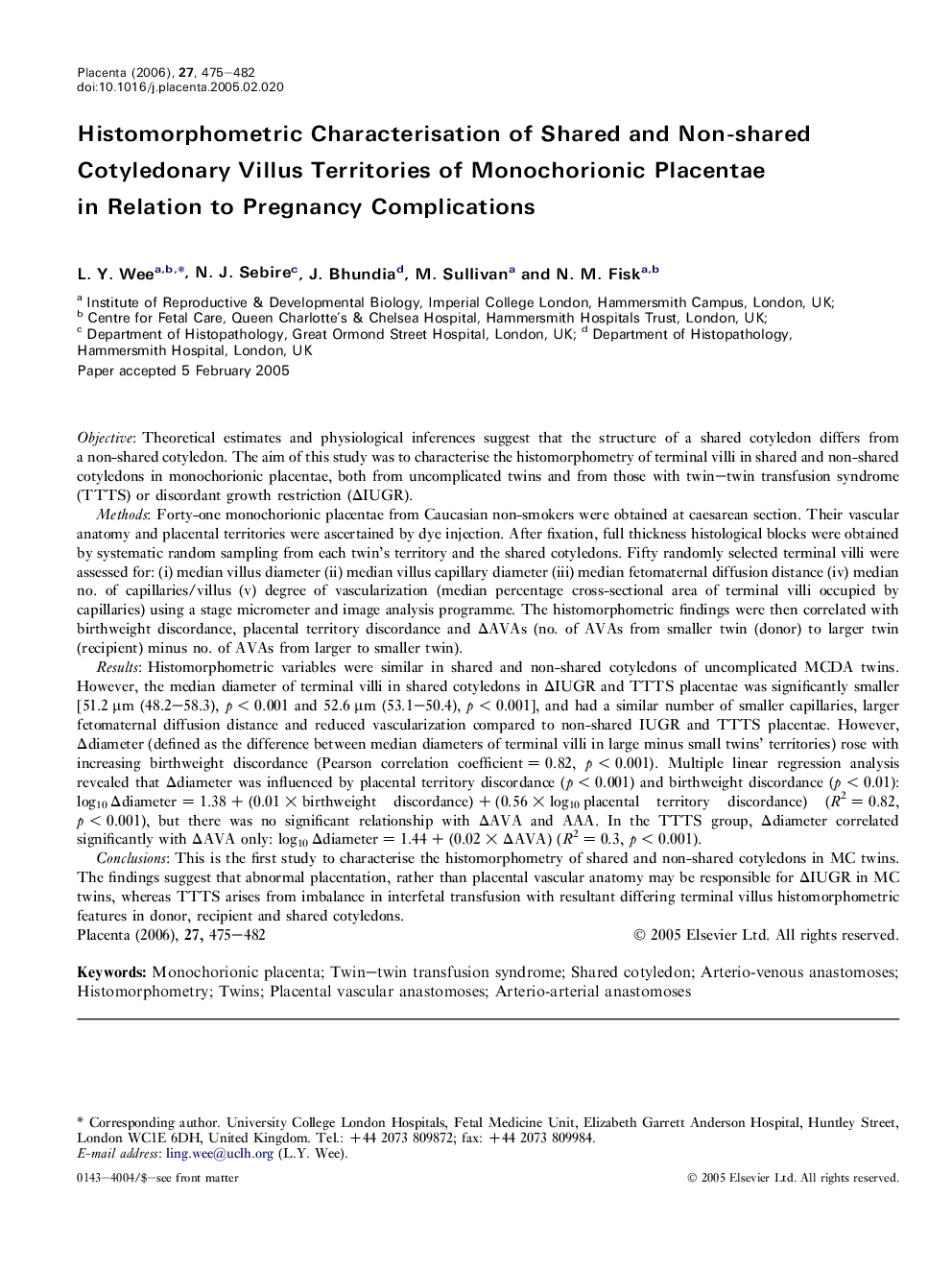| Article ID | Journal | Published Year | Pages | File Type |
|---|---|---|---|---|
| 2790379 | Placenta | 2006 | 8 Pages |
ObjectiveTheoretical estimates and physiological inferences suggest that the structure of a shared cotyledon differs from a non-shared cotyledon. The aim of this study was to characterise the histomorphometry of terminal villi in shared and non-shared cotyledons in monochorionic placentae, both from uncomplicated twins and from those with twin–twin transfusion syndrome (TTTS) or discordant growth restriction (ΔIUGR).MethodsForty-one monochorionic placentae from Caucasian non-smokers were obtained at caesarean section. Their vascular anatomy and placental territories were ascertained by dye injection. After fixation, full thickness histological blocks were obtained by systematic random sampling from each twin's territory and the shared cotyledons. Fifty randomly selected terminal villi were assessed for: (i) median villus diameter (ii) median villus capillary diameter (iii) median fetomaternal diffusion distance (iv) median no. of capillaries/villus (v) degree of vascularization (median percentage cross-sectional area of terminal villi occupied by capillaries) using a stage micrometer and image analysis programme. The histomorphometric findings were then correlated with birthweight discordance, placental territory discordance and ΔAVAs (no. of AVAs from smaller twin (donor) to larger twin (recipient) minus no. of AVAs from larger to smaller twin).ResultsHistomorphometric variables were similar in shared and non-shared cotyledons of uncomplicated MCDA twins. However, the median diameter of terminal villi in shared cotyledons in ΔIUGR and TTTS placentae was significantly smaller [51.2 μm (48.2–58.3), p < 0.001 and 52.6 μm (53.1–50.4), p < 0.001], and had a similar number of smaller capillaries, larger fetomaternal diffusion distance and reduced vascularization compared to non-shared IUGR and TTTS placentae. However, Δdiameter (defined as the difference between median diameters of terminal villi in large minus small twins' territories) rose with increasing birthweight discordance (Pearson correlation coefficient = 0.82, p < 0.001). Multiple linear regression analysis revealed that Δdiameter was influenced by placental territory discordance (p < 0.001) and birthweight discordance (p < 0.01): log10 Δdiameter = 1.38 + (0.01 × birthweight discordance) + (0.56 × log10 placental territory discordance) (R2 = 0.82, p < 0.001), but there was no significant relationship with ΔAVA and AAA. In the TTTS group, Δdiameter correlated significantly with ΔAVA only: log10 Δdiameter = 1.44 + (0.02 × ΔAVA) (R2 = 0.3, p < 0.001).ConclusionsThis is the first study to characterise the histomorphometry of shared and non-shared cotyledons in MC twins. The findings suggest that abnormal placentation, rather than placental vascular anatomy may be responsible for ΔIUGR in MC twins, whereas TTTS arises from imbalance in interfetal transfusion with resultant differing terminal villus histomorphometric features in donor, recipient and shared cotyledons.
